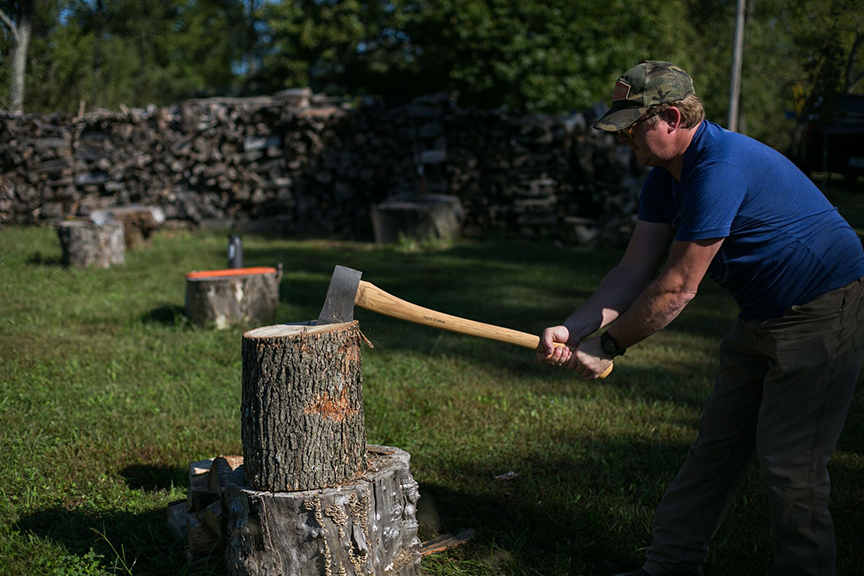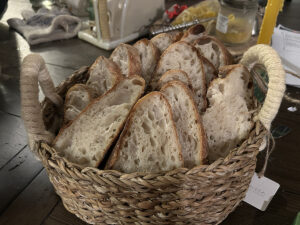
The first real step to heating with wood is to find the wood that is to be processed into fuel. Around half of my property is wooded in various hardwoods, from hickory, oak and locust to softer hardwoods like poplar, sycamore and sasafrass. There is lots of deadfall and lots of trees that can be cut and worked up into dandy stacks of firewood. However, I leave these woods be. I never cut a living tree with the sole purpose of making firewood. Although I heat with wood and have an impressive collection of tools that are made for turning living trees into firewood, I am a bit of a conservationist when it comes to the trees themselves, and feel like it’s much more responsible to plant trees. That means I must seek my fuel elsewhere. This isn’t a difficult task, and I encourage anyone that has ambitions to heat with wood, inside or out, to give it a try.
Finding Firewood
I admit to being a scavenger of firewood. When a storm ravages a neighborhood, I will spend my lunch break surveying the damage and approach homeowners about helping them clean up their newly acquired mess. Most are eager to trade the labor for the wood. Once this happens a time or two in a given area, people then begin to call me to come and take a look at their windfalls. Tree trimmers and utilities are also handy sources of free wood. If they don’t have to haul the wood off, it’s better for their business, and thus I am doing them a favor. Every once in a while a dump truck shows up at my house full of mixed hardwood. This is even better, since it is there and in the woodlot for me to process at my leisure. Due to this front end leg work of building a word of mouth network of free wood sources, I am able to let the trees around me flourish and live. I may have to settle for some wood that isn’t all-night burning wood like the mighty oak, but all wood has a place in the woodlot. If used properly, each type of tree can be put to best use so that little to nothing is wasted when the times comes.
The Different Types of Firewood
The regal burning woods are well known. Oak, hickory, pecan, locust, osage orange and beech are my favorites for hot, coal heavy fires that last for hours. These are the woods that people will pay the top dollar for if buying their own firewood and for good reason. They burn hot, really hot, and for a long time. This is what I consider coal wood. When I am lucky enough to get some of this stuff, I cut it accordingly. The wood is split into large pieces with the purpose of being overnight or all day burners. The limb wood is also harvested for nice additions to mixed wood pile. Even the tiny twigs are reserved chopped up and piled high on the wood stacks as this fuel is some of the best fire starter there is.
The next group of woods aren’t far off the mark from those above. They are sugar maple, cherry, ash, hackberry, mulberry, persimmon, walnut, and the birches. These woods balance out between being super easy to work and easy to burn, while producing great heat. They don’t burn quite as long or as hot as some of those mentioned earlier, but they should never be turned down, especially if they’re free. Also, some of these are often in yards and provide common curbside windfall after storms. No parts of these trees are left behind barring rot or a triple forked piece that would require nitroglycerin to separate.
Lastly comes the lightest of the hardwoods common to my neck of the woods. Elm, poplar, red maple, sycamore, box elder, cottonwood and basswood. I call these ashy woods. They will burn, but produce lots of ash versus the amount of heat they give out. That doesn’t mean they should be left behind. A load of red maple or sycamore split down into 2-4 inch billets is a great addition to the woodlot. These woods, especially combined with those in the middle group area, are a great resource to getting a nice, hot fire fast that will get those larger pieces of the premium wood rocking in no time.
All of these species should be split and stacked off the ground (I like pallets) and in the sun for at least a summer season before burning. Some, like oak, really need a couple of summers to reach maximum potential.
****
 Patrick and his family live on a small farm where they heat with firewood and raise chickens and bees. They built a small home so that they could enjoy a nice simple lifestyle, which gives them family time and time to spend outside working their land. Patrick splits about 20 cords of wood a year by hand with an axe and a wedge, no hydraulics required.
Patrick and his family live on a small farm where they heat with firewood and raise chickens and bees. They built a small home so that they could enjoy a nice simple lifestyle, which gives them family time and time to spend outside working their land. Patrick splits about 20 cords of wood a year by hand with an axe and a wedge, no hydraulics required.

































[…] Editor’s Note: Want to learn more about wood heating? Make sure to check out Patrick’s posts about splitting wood by hand and how to choose the right firewood. […]
Great article!
Like your conservative approach. Living in the North East within city limits most of my harvesting is “hurricane “ wood or homeowners having trees cut down.
Thank you for reading, Renee!